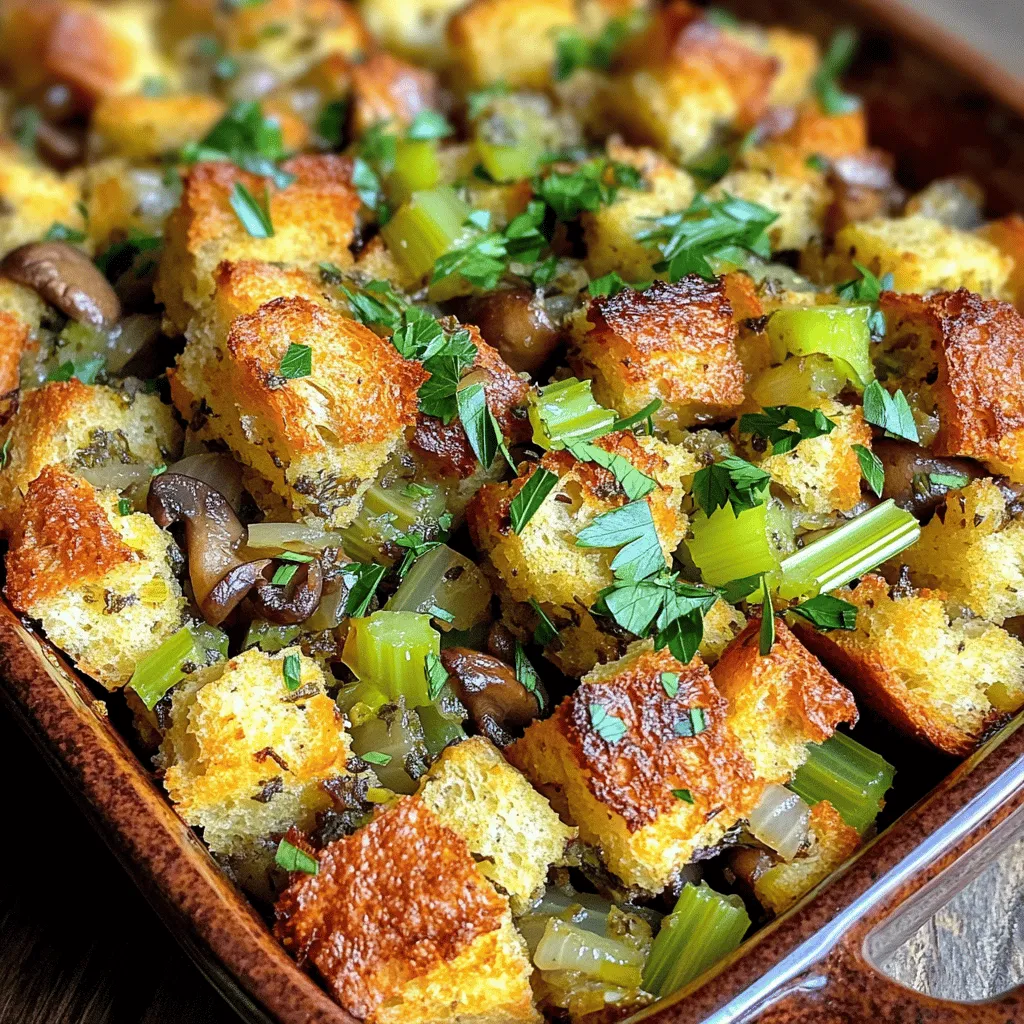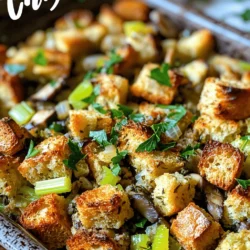There’s nothing like the taste of classic homemade stuffing, especially during the holidays! In this easy recipe, I’ll guide you through making a simple yet flavorful stuffing that will impress your family and friends. With just a few key ingredients and some handy tips, you’ll create a dish that complements any meal. Ready to elevate your cooking game? Let’s dive into this delightful stuffing recipe!
Ingredients
List of Ingredients
– Rustic bread cubes
– Diced vegetables
– Herbs and spices
– Broth and seasonings
Ingredient Substitutions
You can swap the rustic bread with other types. Use sourdough or whole grain bread for a twist. If you want a gluten-free option, try gluten-free bread. For vegetables, celery and onion are classic, but feel free to use leeks or carrots. You can also add bell peppers for sweetness. If you don’t have vegetable broth, chicken broth works well too. Water can be a last resort, but it lacks flavor.
Fresh vs. Dried Ingredients
Using fresh herbs makes a big difference in flavor. Fresh parsley, for example, adds brightness. Dried herbs can still work, but they lose some potency. Rehydrating dried herbs in hot water first can help. This way, they release their flavor better. Fresh herbs should be added at the end to keep their taste vibrant.
Step-by-Step Instructions
Preparing the Bread
To start, you need dry bread cubes. I recommend using rustic bread for the best taste. First, preheat your oven to 350°F (175°C). Spread the cubed bread on a baking sheet. Toast it in the oven for about 15 minutes. You want the bread to be slightly golden. This toasting process helps the bread hold up when you add the broth. Dry cubes soak up the flavors but stay firm. Avoid using soft bread; it can make the stuffing mushy.
Sautéing the Vegetables
Next, let’s sauté the vegetables. In a large skillet, melt 1/2 cup of unsalted butter over medium heat. Add 1 cup each of diced celery and onion. Cook them for about 5 minutes until they soften. Then, stir in 1 cup of diced mushrooms and 2-3 minced garlic cloves. Cook these for another 3-4 minutes. This timing helps develop the flavors. Make sure the mushrooms are tender before moving on. The aroma will fill your kitchen!
Combining Ingredients
Now it’s time to bring everything together. In a large mixing bowl, combine the toasted bread and your sautéed vegetables. Gradually pour in 2-3 cups of vegetable broth. Start with 2 cups and add more if needed. You want the bread to be moist but not soggy. Mix gently to coat all the bread cubes evenly. This step ensures that every bite is full of flavor. Finally, fold in 1/4 cup of chopped fresh parsley for a pop of color and taste. This is crucial for a fresh finish, making your stuffing stand out.
Tips & Tricks
Flavor Enhancements
To boost the taste of your stuffing, try adding nuts or dried fruits. Walnuts, pecans, or dried cranberries add a nice crunch and sweetness. Just chop them up and mix them in with the bread. Adjusting seasoning can also make a big difference. Always taste your mix and add more salt, pepper, or herbs as needed.
Making Ahead
You can prepare stuffing early for a stress-free cooking day. Start by following the recipe up to mixing in the broth. Then, cover your bowl and store it in the fridge for up to two days. Make sure to keep it safe by using an airtight container. When you’re ready to bake, just add broth and follow the baking steps.
Baking Perfectly
To get a golden and crispy top, bake your stuffing uncovered for the last 10-15 minutes. This lets the heat circulate and creates that perfect crunch. To avoid sogginess, don’t add too much broth. Start with two cups and add more only if needed. The bread should soak up the liquid but not drown in it.

Variations
Different Bread Choices
You can use different types of bread for stuffing. Cornbread adds a sweet touch. It gives a nice texture and flavor. Bagels can also work well. They create a chewy, hearty stuffing. Both options change how the stuffing tastes and feels.
Using rustic bread is classic, but getting creative is fun. Try using a mix of breads. This can add depth to your dish. Each type brings its own flavor and texture. You can play with what you like best.
Regional Variations
Regional styles of stuffing are diverse and tasty. Southern-style stuffing often includes sausage and spices. This adds richness and warmth to the dish. In contrast, some people prefer vegetarian or vegan stuffing. You can use mushrooms, nuts, or beans as protein sources.
Adding seasonal vegetables boosts flavor and nutrition. This way, you can make stuffing that fits your diet and tastes. Everyone can enjoy a version that suits their needs.
Unique Ingredients
Think outside the box when adding unique ingredients. Sausage can add a savory kick. It pairs well with herbs to enhance flavor. Seafood is another option. Shrimp or crab can create a coastal twist.
When using unique ingredients, consider your flavor profiles. Balance rich flavors with fresh herbs. This keeps the stuffing light and exciting. Don’t hesitate to experiment. You might find a new favorite recipe.
Storage Info
Refrigeration Guidelines
Cooked stuffing lasts for about three to four days in the fridge. To keep it fresh, store it in an airtight container. When ready to eat, reheat it in the oven or microwave. If using the oven, cover it with foil to keep moisture in. Heat until it’s warm all the way through. This method helps preserve its flavor and texture.
Freezing Stuffing
You can freeze stuffing either before or after baking. To freeze before baking, assemble the stuffing and place it in a freezer-safe dish. Cover it tightly, then freeze. To freeze after baking, let it cool completely before wrapping it. Use freezer wrap or a zip-top bag. When ready to use, thaw it in the fridge overnight. Bake it at 350°F (175°C) until heated through.
Signs of Spoilage
Check for signs of spoilage before eating. Look for mold, bad smells, or a slimy texture. These signs mean it’s time to throw it away. Always practice good food safety. If you are not sure about the stuffing, it is better to be safe than sorry. Enjoy your stuffing while it’s fresh to savor that homemade flavor!
FAQs
What can I use instead of broth?
You can use water if you need a quick option. Homemade stock adds great flavor too. Just simmer bones, veggies, and herbs in water to create your stock. This option brings extra taste to your stuffing.
Can stuffing be made without bread?
Yes, you can make stuffing without bread. Try using cooked rice or quinoa as a base. Cauliflower rice also works well for a gluten-free version. These options provide a different texture but still hold the flavors.
How do I make stuffing moist?
To keep your stuffing moist, adjust the liquid amounts carefully. Start with two cups of broth. Add more if the mix feels too dry. You want it damp but not soggy. Mixing well helps distribute moisture evenly.
Is it safe to stuff the turkey with homemade stuffing?
Stuffing your turkey can be safe, but you must follow some rules. First, cook your stuffing to at least 165°F (73.9°C). This temperature kills any harmful bacteria. If you stuff the turkey, cook it right after stuffing. Never leave it sitting. Always check the center of the stuffing for doneness. This ensures a safe and tasty meal.
Making stuffing is simple and fun. You learned about key ingredients like bread, veggies, and broth. We covered ways to swap ingredients and tips for using fresh versus dried herbs. The step-by-step instructions helped you prepare and bake your stuffing just right.
Remember, you can add unique ingredients or try different bread types for variety. Store leftovers properly to enjoy later. With these tips in mind, you’re now ready to make stuffing that will impress everyone. Enjoy your cooking!


